|
Contents
Ports-to-Plains Alliance holds successful Virtual Annual Conference
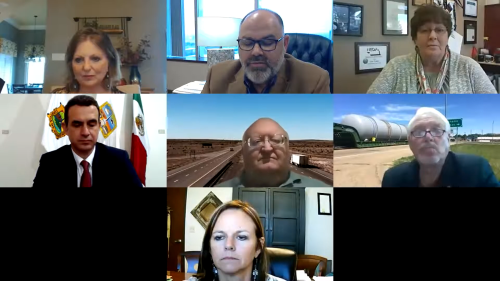
Going virtual for an Annual Conference was very successful and a huge thanks to everyone who participated. The number of attendees was strong and international in scope. The presentations and a video of the entire conference (1.5 hours) are available at: https://portstoplains.com/index.php/home/presentations. Below are highlights of the presentations during the conference.
Heartland Expressway Association
Deb Cottier, Chair of the Heartland Expressway Association (HEA), provided an update on the activities of HEA. The Association held a socially distanced Annual Luncheon in August in Gering, Nebraska and heard from U.S. Senator Deb Fischer and Congressman Adrian Smith virtually, regarding their continued support for the Nebraska Department of Transportation (NDOT) continuing work on the four-lane expressway through western NE.
HEA also heard from Kyle Schneweis, Director of the NDOT, regarding upcoming events including bid letting (November 19, 2020) for the portion of the route (a 20+ mile section of US 385 from the L62a junction north to where the previous 4-lane expansion stopped south of Alliance). We also saw slides regarding the route and timeline for finishing the portion of the Expressway from that junction west to the existing four-lane at Minatare, Nebraska.
Kyle Schneweis, Director of NDOT was stepping down the end of October, so Nebraska will be looking for a new director in 2021. Kyle is well respected for his leadership within the department will be missed. He is joining a national consulting firm called High Street as their CEO.
HEA has plans to ask for a meeting with NDOT to discuss future Interstate designation, among other things, but will re-assess the timing on that, given Schneweis’ departure.
Government of Coahuila
Representing the Government of Coahuila, Jorge Ramon Montemayor, Undersecretary of Promotion and Strategic Projects, provided information on the economic development efforts in Coahuila as well as the Coahuila Governor’s priorities for transportation infrastructure.
Undersecretary Ramon was clear that Coahuila is part of the Port-to-Plains Strategy, which connects USA, Canada and Mexico. He identified four Strategic Border Projects: 1) A second International Bridge at CD Acuña; 2) Modernization of the existing Port of Entry at Acuña (recently completed); 3) Rail Improvements on Piedras Negras International Bridge II; and 4) a third International Bridge at Piedras Negras.
In terms of improving connections within Coahuila, priorities include $50 million of improvements to Highway 57 by constructing three relief routes (loops) and $35 million to provide four relief routes (loops) on Highway 30.
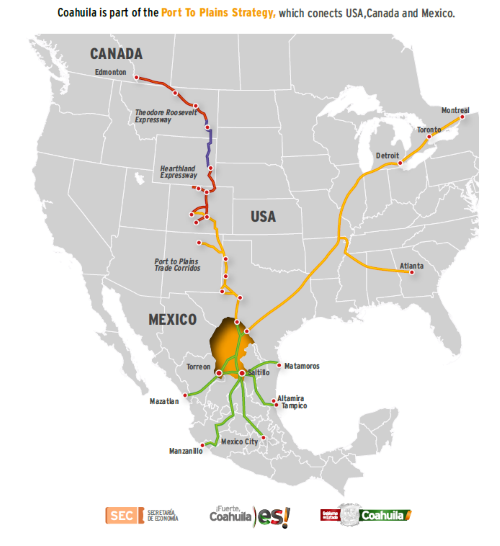
Theodore Roosevelt Expressway Association
Executive Director Cal Klewin provided an update on the status of the Theodore Roosevelt Expressway (TRE) including updates in North Dakota, South Dakota and Montana. In North Dakota, following the completion of the Environmental Impact Study for U.S. Highway 85 between Watford City and I-94 at Belfield, the first construction project of the Long X four-lane bridge replacement across the Little Missouri River was nearing completion (see article on the Long X Bridge Ribbon Cutting).
Ports-to-Plains Corridor
John Osborne, Chair of the Ports-to-Plains Alliance, provided an update including the results of the Ports-to-Plains Corridor Interstate Feasibility Study in Texas, and the status of federal legislation designating the entire Ports-to-Plains Corridor in Texas, New Mexico, Oklahoma and Colorado and a portion of the Heartland Expressway in Colorado. It was very important that TxDOT has provided Congress a letter supporting Future Interstate Designation.
For New Mexico, Chairman Osborne highlighted the support of the New Mexico Department of Transportation who not only provided a letter to Congress supporting the Future Interstate Designation, but also the New Mexico DOT has funded a study of a Future Interstate in New Mexico which will provide an economic analysis and impact review of upgrading the existing four-lane divided highway to an interstate.
For Colorado, CDOT has provided Congress a letter stating: “The Colorado Department of Transportation (CDOT) is not opposed to Congressional action to designate the Ports-to-Plains Corridor, which is a Congressionally-designated High Priority Corridor, as a future Interstate Highway. Communities along the proposed route across rural eastern Colorado have strongly supported this designation.”
CDOT Region 4 also released the results of the Colorado Highway 71 Truck Freight Diversion Study showing improving the Heartland Expressway (Highway 71) in Colorado to a four-lane divided highway would provide a 7-9% reduction on I-25 of Truck Vehicle Miles Traveled. This VMT reduction translated to over 1,100 trucks per day diverting from I-25 to the Heartland Expressway. The four-lane divided highway had an estimated cost of $483 million with a benefit of $593 million. This results in a Benefit-Cost Ratio of 1.23 with a Net Present Value of $110 million.
Finally, CDOT continues the process of developing new Passing Lanes on the Ports-to-Plains Corridor (U.S. 287). To date $31.4 million including an $8.297 million INFRA Grant, $10.5 million of National Highway Freight Program formula funds and state funds to construct multiple passing lanes on the Ports-to-Plains Corridor between Oklahoma and Limon, CO.
Return to contents
Long X Bridge holds Ribbon-Cutting in North Dakota
On October 30, 2020 the Long X Bridge Four-Lane Replacement celebrated its opening with a ribbon cutting by officials of the North Dakota Department of Transportation (NDDOT), State Legislators, and City Officials from Williston and Watford City.
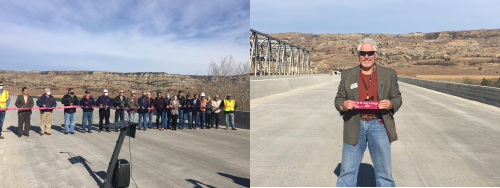
Congratulations to Executive Director Cal Klewin (pictured above right) and Theodore Roosevelt Expressway!
A long time priority project for the Theodore Roosevelt Expressway Association, this bridge, over the Little Missouri River near the entrance to the Theodore Roosevelt National Park North Unit, has been closed several times for lengthy repairs when truckers with over-height loads have collided with the overhead girders. If the load limits are in place and the bridge is out, freight haulers previously faced up to a 300-mile detour.
“The state of North Dakota invested $37.4 million to transform the Long X Bridge into a safe and accessible passageway,” said Bill Panos, Director of NDDOT. “U.S. Highway 85 and this bridge are essential to transportation movement in western North Dakota.”
The project included a complete bridge replacement, highway construction and the addition of the wildlife crossing. The new bridge is a concrete girder bridge and will have four, 12-foot driving lanes. Around 4,200 vehicles crossed the old bridge daily, and the new structure will allow for larger, wider truck loads that previously were not capable to cross.
Return to contents
Ports-to-Plains Overview
Source: Ports-to-Plains Corridor Interstate Feasibility Study
What are the Population Trends in the Corridor?
The Ports-to-Plains Advisory Committee reviewed findings on current and forecasted conditions and analysis for the Corridor to determine future needs and challenges of the Corridor between 2020 and 2050. The future analysis presents the baseline condition, which includes the existing roadways in the Corridor, plus any currently planned and programmed projects by TxDOT or Metropolitan Planning Organizations in the Corridor. The baseline condition does not include upgrading the Corridor to an interstate.
The Ports-to-Plains Corridor experienced steady growth from 1990 to 2017, growing from 1.4 million in 1990 to 1.8 million in 2017, an increase of 33 percent.
From 2020 to 2050, the Corridor is projected to grow 61 percent, adding over a million people, from approximately two million in 2020 to over three million in 2050.
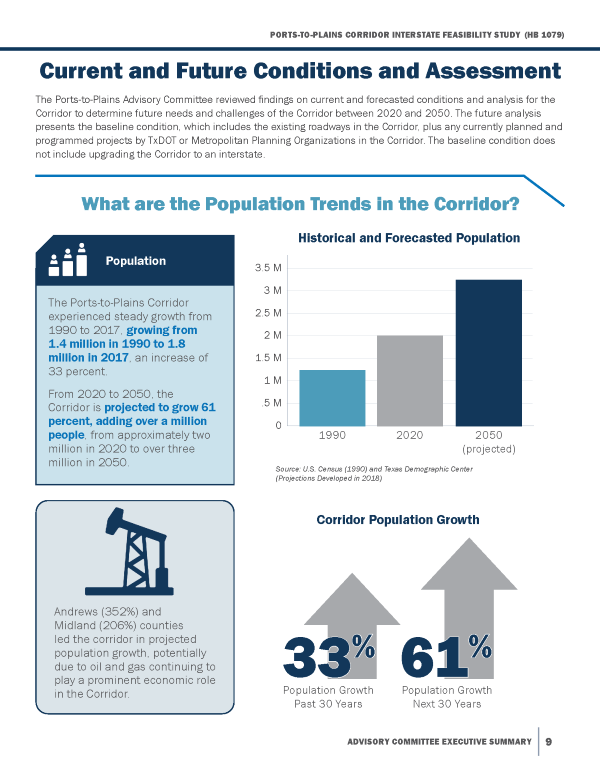
Link to above graphic (pdf)
Return to contents
What is the Current and Future Economic Outlook for the Corridor?
The economy of West and South Texas has grown consistently over the last 20 years. Employment projections show the Ports-to-Plains Corridor employment will grow by 17% from 2020 to 2050.
The Committees found the Ports-to-Plains Corridor median household income more than doubled from 1990 to 2017. Median household income in the Corridor is projected to increase 161% between 2020 and 2050.
GDP in the Corridor more than doubled from 1990 to 2017, an increase of 158%. From 2020 to 2050, the Corridor GDP is projected to increase 69%.
The future projections are good news. The Corridor communities are expected to see a strong economy into the next 30 years. As we will see, any interstate upgrade can make these economic impacts even greater.
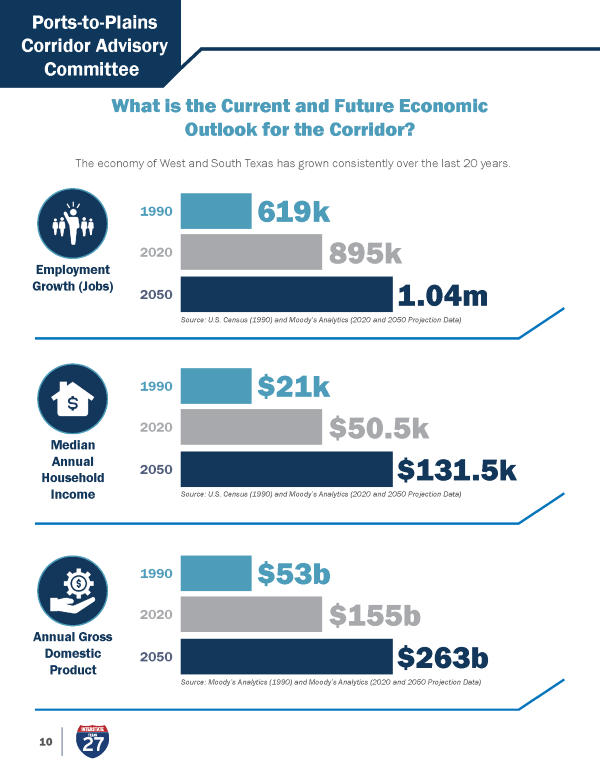
Link to above graphic (pdf)
Return to contents
What are the Travel Times in the Corridor?
The 2050 Baseline represents the current corridor plus the next ten years of projects that are planned and programmed by TxDOT and the MPOs. These projects are included in the 2020 Unified Transportation Plan (UTP).
The planned and programmed projects will result in a reduced Travel Time across the Corridor of about 20 minutes for the entire 963-mile corridor.
What are the Safety Conditions in the Corridor?
The addition of the planned and programmed projects will reduce the crash rate from 115 crashes per million vehicle miles traveled in 2018 to 86 crashes in 2050.
The corridor now includes 350 miles of two-lane roadway and 95 miles of four-lane undivided roadway – these facilities have statewide crash rates that are 48% to 97% higher than statewide crash rates for interstate facilities.
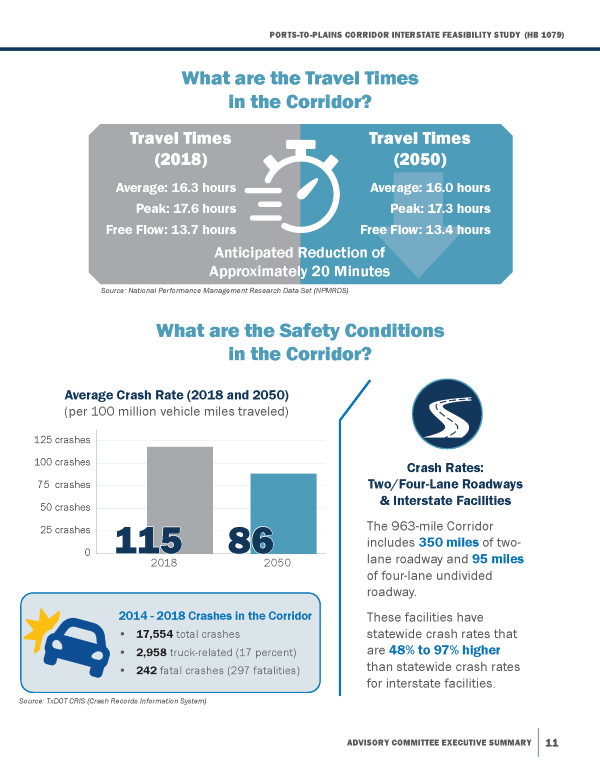
Link to above graphic (pdf)
Return to contents
What is the Freight Flow and Tonnage in the Corridor?
Freight volumes are projects to grow by 76% between 2018 and 2050 with the planned and programmed projects.
Freight flow along the Corridor is generated by the three international border crossings in Laredo, Eagle Pass, and Del Rio. The truck flows from these port-of-entries reach all regions of the United States and into Canada.
Nearly 80% of trade moving across the border at these three border crossings is moved by trucks.
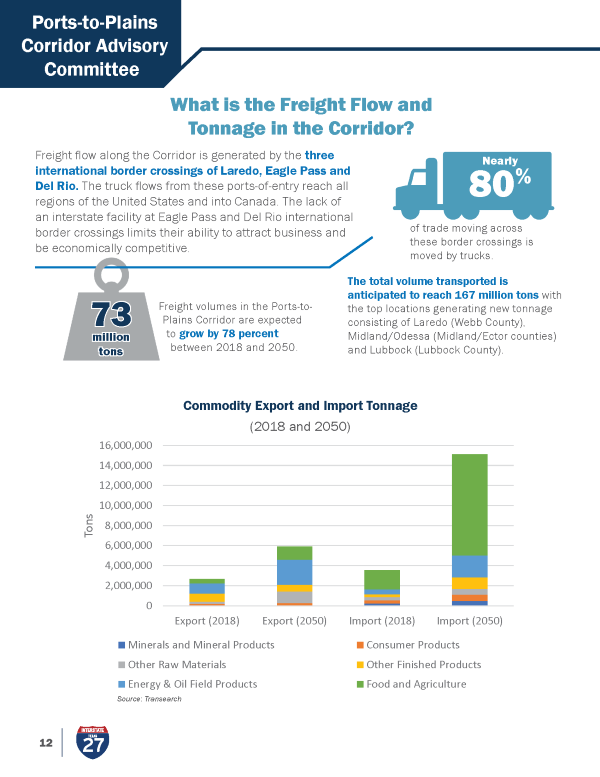
Link to above graphic (pdf)
Return to contents
Freight Flow & Tonnage: Current Export and Import Markets
In terms of exports through the three border crossings on the Ports-to-Plains Corridor, just over two-thirds of the total exported value, will come from states west of the Mississippi River in 2050.
Nearly three-quarters of the total imported value will be bound to states west of the Mississippi River by 2050.
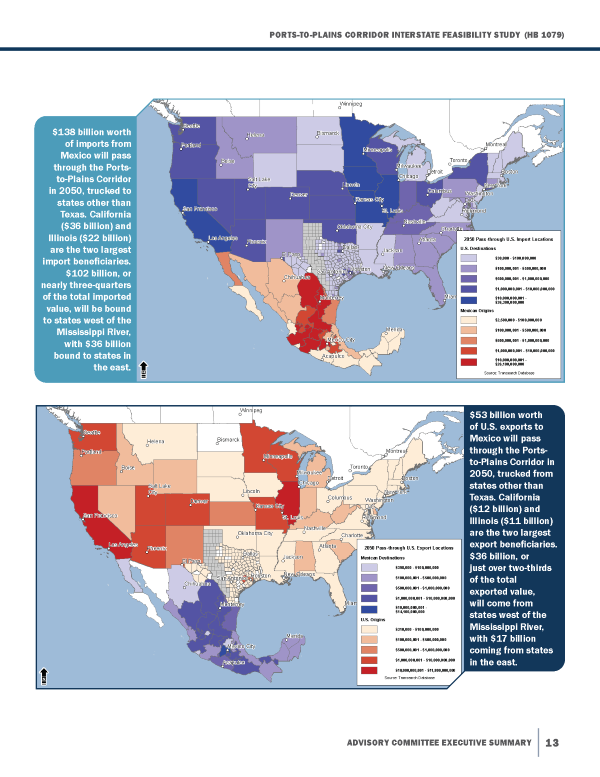
Link to above graphic (pdf)
Return to contents
Check out the newest Ports-to-Plains Video!
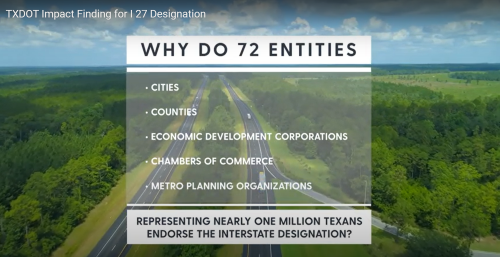
Click to View This Video
Return to contents
|